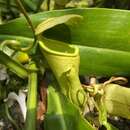en
names in breadcrumbs


These carnivorous plants have been shown to exhibit UV to blue fluorescence. Fluorescence involves the absorption of light at one wavelength, followed by the release of the light energy at a different wavelength. In this case, light in the ultraviolet range (shorter than 400nm) is absorbed and re-emitted as blue light (430-480nm). (Kurup et al, 2013)
These plants probably make use of the blue light as an attractant to lure insect prey in flight overhead. Pitfall trap predators like Nepenthes and Sarracenia fluoresce from the peristome and lid, the portions near the entrance to the pitfall. Their pitcher fluid is also fluorescent. Dionaea muscipula, a snap-trap, captures prey by rapid closure of the leaves, and in this species the inner surface of the leaf traps show blue fluorescence. (Kurup et al, 2013)
Not all carnivorous plants appear to share this tactic. Drosera and Pinguicula, both flypaper-style traps, as well as Utricularia, a bladder trap, were tested in the same study and no blue fluorescence was found.
Nepenthes khasiana (/nɪˈpɛnθiːz ˌxæsiˈɑːnə/; after the Khasi Hills, to which it is largely endemic) is an endangered tropical pitcher plant of the genus Nepenthes. It is the only Nepenthes species native to India. It is thought to attract prey by means of blue fluorescence.[4]
The species has a very localised distribution and is rare in the wild. But with new advancement in agro-technology and tissue culture, it is now being cultivated in campus of Nagaland University, Nagaland. These Pitcher Plants which are endemic to Meghalaya can be seen widely as decorative plants outside many houses of Nagaland.[5]
Isolated populations are known to occur in the Jarain area of the Jaintia Hills, the Baghmara area of the Garo Hills, adjacent to the Khasi Hills region of Meghalaya, in the Upper Kharthong area, of Dima Hasao district Assam and in some parts of Nagaland.[6]
Nevertheless, N. khasiana exhibits considerable genetic diversity.[7] The Khasi people call the plant tiew-rakot, which means demon-flower or devouring-plant. The Jaintias call it kset phare, which is roughly translated as lidded fly net. The Garo call the plant memang-koksi, which literally means the basket of the devil[8][9] and the Biate tribe of Assam call the plant Jug-Par which means Jug-flower or Loisul Kola which literally means Pitcher-plant.[6]
Nepenthes khasiana is a protected species, classified as endangered,[1] and is listed under CITES Appendix I meaning commercial international trade is prohibited.[2] Threats to wild populations include habitat destruction, acid mine drainage associated with coal mining, and collection for medicinal and ornamental uses.[8][10] In 2010, the Rare Nepenthes Collection was established with the aim of conserving 4 of the most threatened Nepenthes species: N. aristolochioides, N. clipeata, N. khasiana, and N. rigidifolia.[11][12][13]
The specific epithet khasiana is spelled khasyana in some older texts.[14][15] This spelling actually predates that under which the species was formally published in Joseph Dalton Hooker's 1873 monograph, "Nepenthaceae",[3] as it appeared in an article by Maxwell T. Masters in the April 20, 1872 issue of The Gardeners' Chronicle and Agricultural Gazette (this article was itself based on the manuscript of Hooker's monograph).[15] In the horticultural trade of the late 19th century, N. khasiana was often confused with N. distillatoria of Sri Lanka.[15][16][17][18]
Nepenthes khasiana (/nɪˈpɛnθiːz ˌxæsiˈɑːnə/; after the Khasi Hills, to which it is largely endemic) is an endangered tropical pitcher plant of the genus Nepenthes. It is the only Nepenthes species native to India. It is thought to attract prey by means of blue fluorescence.
The species has a very localised distribution and is rare in the wild. But with new advancement in agro-technology and tissue culture, it is now being cultivated in campus of Nagaland University, Nagaland. These Pitcher Plants which are endemic to Meghalaya can be seen widely as decorative plants outside many houses of Nagaland.
Isolated populations are known to occur in the Jarain area of the Jaintia Hills, the Baghmara area of the Garo Hills, adjacent to the Khasi Hills region of Meghalaya, in the Upper Kharthong area, of Dima Hasao district Assam and in some parts of Nagaland.

Nevertheless, N. khasiana exhibits considerable genetic diversity. The Khasi people call the plant tiew-rakot, which means demon-flower or devouring-plant. The Jaintias call it kset phare, which is roughly translated as lidded fly net. The Garo call the plant memang-koksi, which literally means the basket of the devil and the Biate tribe of Assam call the plant Jug-Par which means Jug-flower or Loisul Kola which literally means Pitcher-plant.

A Pitcher plant from Vaitang Hebron village,Dima Hasao district, Assam, India
Nepenthes khasiana is a protected species, classified as endangered, and is listed under CITES Appendix I meaning commercial international trade is prohibited. Threats to wild populations include habitat destruction, acid mine drainage associated with coal mining, and collection for medicinal and ornamental uses. In 2010, the Rare Nepenthes Collection was established with the aim of conserving 4 of the most threatened Nepenthes species: N. aristolochioides, N. clipeata, N. khasiana, and N. rigidifolia.
The specific epithet khasiana is spelled khasyana in some older texts. This spelling actually predates that under which the species was formally published in Joseph Dalton Hooker's 1873 monograph, "Nepenthaceae", as it appeared in an article by Maxwell T. Masters in the April 20, 1872 issue of The Gardeners' Chronicle and Agricultural Gazette (this article was itself based on the manuscript of Hooker's monograph). In the horticultural trade of the late 19th century, N. khasiana was often confused with N. distillatoria of Sri Lanka.

Intermediate pitcher of cultivated mature plant

Upper pitcher of cultivated mature plant